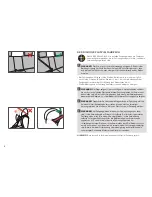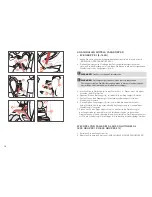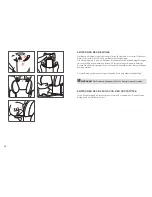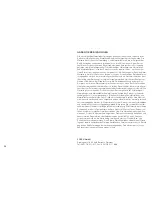
DE
EN
IT
17
SECURING THE CHILD WITHOUT THE IMPACT SHIELD
– ECE GROUP 2/3 (15-36 KG)
ALLACCIAMENTO SENZA CUSCINO DI SICUREZZA
– GRUPPO ECE 2/3 (15-36 KG)
1.
Place your child in the child car seat. Pull the three-point belt right out and feed
it along the belt buckle (l) in front of your child.
1. Collocare il bambino nel seggiolino. Estrarre ampiamente la cintura a tre punti e
farla scorrere fino al fermaglio della cintura (l) davanti al bambino.
2.
Insert the belt tongue (m) into the belt buckle (l). It must lock into place with an
audible “CLICK”.
3. Next, place the lap belt (n) in the lower belt guides (k) of the child car seat.
4.
Now pull the diagonal belt (f) firmly to tighten the lap belt (n). The tighter the belt
sits, the better it provides protection from injury. On the side of the belt buckle
(l), the diagonal belt (f) and the lap belt (n) must be inserted together in the lower
belt guide (k).
2.
Inserire la linguetta della cintura (m) nel fermaglio della cintura (l). Il blocco in
posizione deve essere segnalato da uno scatto udibile.
3.
Collocare successivamente la cintura subaddominale (n) nelle guide della cintura
inferiori (k) del seggiolino.
4.
Tirare ora saldamente la cintura diagonale (f) per tendere la cintura subaddominale
(n). Maggiormente tesa è la sede della cintura e maggiore è la protezione dalle
lesioni. Cintura diagonale (f) e cintura subaddominale (n) vanno inserite assieme
nella guida della cintura inferiore (k) a lato del fermaglio della cintura (l).
ATTENZIONE!
Non torcere mai la cintura.
!
ATTENZIONE!
La cintura subaddominale (n) deve scorrere più bassa
possibile su ambo i lati lungo l‘inguine del bambino per avere l‘effetto ottimale
in caso di incidente.
!
ATTENZIONE!
Il fermaglio della cintura (l) del veicolo non deve mai
attraversare il bracciolo. Se il sistema di cinture è troppo lungo il seggiolino
non è adatto all‘uso in questa posizione nel veicolo. In caso di dubbio
consultare il costruttore del proprio seggiolino.
!
WARNING!
Never twist the belt.
!
WARNING!
The lap belt (n) must run as low as possible on both sides along
your child’s groin to have optimum effect in the event of an accident.
!
WARNING!
The vehicle belt buckle (l) must never cross the arm rest. If the
belt system is too long, the child car seat is not suitable for use in this position
in the vehicle. In case of doubt, please consult the manufacturer of your child
car seat.
!
5.
The lap belt (n) should have been fed through the lower belt guides (k) on both
sides of the seat cushion (d).
5.
La cintura subaddominale (n) dovrebbe passare attraverso le guide della cintura
inferiori (k) su ambo i lati del cuscino di seduta (d).
NOTE!
Teach your child from the start to always ensure that the belt is tight and, if
necessary, how to tighten the belt themselves.
NOTA BENE!
Insegnare al bambino fin dall'inizio a controllare sempre che la cintura
sia tesa e a tenderla autonomamente se necessario.
6.
Now feed the diagonal belt (f) through the upper belt guide (g) in the headrest (e)
until it is inside the belt guide.
6.
Far passare ora la cintura diagonale (f) attraverso la guida della cintura superiore (g)
nel poggiatesta (e) fino a che si trova nella guida della cintura.
Ensure that the diagonal belt (f) runs between the outside of the shoulder and the
neck of your child. If necessary, adjust the height of the headrest to change the posi-
tion of the belt. The height of the headrest (e) can still be adjusted while in the car.
Accertare che la cintura diagonale (f) scorra tra l'esterno della spalla e il collo del
bambino. Se necessario regolare l'altezza del poggiatesta per cambiare la posizione
della cintura. L'altezza del poggiatesta (e) è regolabile anche in auto.
ATTENZIONE!
Non utilizzare punti di contatto portanti diversi da quelli
descritti nelle istruzioni e contrassegnati sul sistema di ritenuta.
!
WARNING!
Do not use any load bearing contact points other than those
described in the instructions and marked in the child restraint.
!
















































